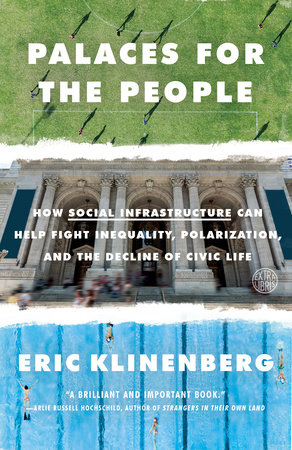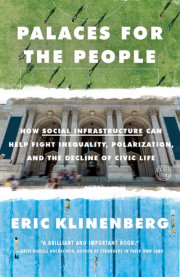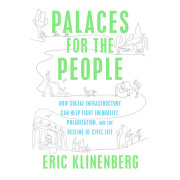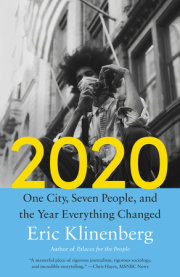Chapter One
A Place to Gather
It’s a balmy Thursday morning in the New Lots neighborhood of East New York, Brooklyn, 70 degrees and sunny on the last day of March. The sidewalks have awakened. Small groups of middle-aged men banter outside bodegas and on stoops of the small, semidetached brick houses that are common in the area. Mothers and grandmothers push strollers and watch over preschool children who hop and skip and revel in the unseasonable warmth. It seems early for recess, but the schoolyards are buzzing. Traffic is light on the narrow residential streets, but occasionally someone honks, a motorcycle engine fires, a truck roars past.
Street life in East New York is busy, but not always congenial. The district is one of the poorest in New York City, with about half the residents living below the poverty line. It’s also one of the most segregated. Nearly 95 percent of residents are black or Latino, and only 1 percent are white. Social scientists sometimes call East New York socially isolated, because its peripheral location and limited public transit options restrict access to opportunities in other parts of the city, while people who don’t live there have little reason to visit and strong incentives to stay away.
The area is among the most violent neighborhoods in New York City, with especially high levels of homicide, felony assault, and sexual assault. Conditions like these are bad for everyone, but research shows that they’re particularly treacherous for older, sick, and frail people, who are prone to hunkering down in their apartments and growing dangerously isolated when they live in inhospitable physical environments. That’s not only what I observed in the Chicago heat wave; it’s what social scientists who conduct large-scale studies of isolation have found as well.
Living in a place like East New York requires developing coping strategies, and for many residents, the more vulnerable older and younger ones in particular, the key is to find safe havens. As on every other Thursday morning this spring, today nine middle-aged and elderly residents who might otherwise stay home alone will gather in the basement of the neighborhood’s most heavily used public amenity, the New Lots branch library.
At first glance, it’s an uninviting facility. The run-down, two-story brown brick building is set back behind a wide sidewalk and bus stop, with a beige stone facade at the entry, a broken chain-link fence on one side and a small asphalt parking lot on the other. In recent years the city designated the library site “African Burial Ground Square,” because it sits atop a cemetery used to inter slaves and soldiers during the Revolutionary War.
The library is small, and it’s already crowded despite the early hour and the good weather. There are two banks of computer terminals with Internet access on the first floor, and patrons, sometimes more than one, at every machine. There’s a small display case holding photographs and short biographies of Nobel Prize winners; tall wooden bookshelves with new releases, atlases, and encyclopedias; an information desk with flyers promoting library events for toddlers, young readers, teens, parents, English-language students, and older patrons. One librarian asks if I need anything. Another stacks books.
I ask to see the second floor, and Edwin, a sweet and soft-spoken information supervisor, takes me upstairs. Here there are three separate universes. A designated children’s space, which is worn but, Edwin says, about to get renovated; a set of tables for English-language courses, which are always oversubscribed; and, in the back, a classroom that serves as the library’s Learning Center, a place where anyone over age seventeen who’s reading below GED level can get special instruction, individually and in groups.
Everyone is welcome at the library, regardless of whether they’re a citizen, a permanent resident, or even a convicted felon. And all of it, Edwin reminds me, is free.
I tell Edwin that I’m here for the event in the basement community room, and it turns out he’s heading there too. We walk downstairs together and he points out the building’s deterioration. The shelves, ceilings, stairwells, and wall panels are wearing out. Wires are exposed. There are rusted toilets and sinks in the bathroom. The doors don’t close properly. In the community room there’s an aging, cream-colored linoleum floor, glaring fluorescent lights, wood paneling, and a small stage strewn with plastic stacking chairs. I think about the burial ground that was here and I realize we can’t be far from the bones.
The community room serves many purposes: theater, classroom, art studio, civic hall. But this morning two staff members, Terry and Christine, will transform it into something unusual: a virtual bowling alley. They’ve arrived early to set up a flat screen television, link an Xbox to the Internet, clear out a play space, and assemble two rows of portable chairs. It’s opening day of the Library Lanes Bowling League, a new program that encourages older patrons in twelve libraries in Brooklyn to join local teams and compete against neighboring branches. Nine people at New Lots signed up to play, and after weeks of practice, they’re about to take on Brownsville and Cypress Hills.
Branch libraries offer something for everyone, but the extra services and programming that they provide for older people are particularly important. As of 2016, more than twelve million Americans aged sixty-five and above live by themselves, and the ranks of those who are aging alone is growing steadily in much of the world. Although most people in this situation are socially active, the risk of isolation is formidable. A fall, an illness, or the inevitable advance toward frailty can render them homebound. If older friends and neighbors move away or die, their social networks can quickly unravel. If they get depressed, their interest in being out in the world can diminish. Street crime discourages everyone from going outdoors and socializing in public, but it’s particularly intimidating for the old. In neighborhoods where crime is high or the social infrastructure is depleted, old people are more likely to stay home, alone, simply because they lack compelling places to go.
New Lots has its library, though, and today the doors open at 10 a.m. Soon after, ten patrons, eight women and two men (one who’s here to watch) ranging in age from fifty to nearly ninety, walk downstairs. Among them are Miss Jonny, who sports wraparound sunglasses, tall red boots, a black-and-red polka-dot scarf, and a gray newsboy cap. There’s Suhir, in a seafoam sweat suit and a white hijab. Santon, a soft-spoken man from Guyana, dons a blue baseball cap and loose-fitting green trousers. Una, Bern, Salima, Miba, Daisy, and Jesse round out the crew. They greet one another warmly. Some women hug. A few clasp hands. Daisy gives Una a gentle high five that turns into a longer touch and a smile.
Terry, an ebullient library information specialist with big eyes and a dazzlingly bright smile, hands each player a royal blue bowling shirt with a white public library logo on the front pocket and team new lots in yellow on the sleeve. Terry is the team’s coach and cheerleader, and she’s trying to pump them up for the match. Christine, a veteran librarian who wears rectangular glasses and holds a pencil and a phone in her shirt pocket, is the lead organizer, having recruited participants from the computer classes and book clubs she leads at the library. Terry and Christine walk around the room and help the participants get into their uniforms, buttoning and pulling them down so they won’t snag when it’s time to bowl.
When everyone is outfitted the players take their seats, making small talk and tapping their toes in anticipation. Christine tries to link the Xbox to the machine in the basement at the Brownsville Library, where their opponents, invisible to us but no doubt similarly composed, have put on their own uniforms and settled in for the match. It worked perfectly in practice, but this time there’s something wrong with the connection. Christine calls Brownsville. Yes, they’re there, just working on the Wi‑Fi. In a few minutes, the machines are in sync and the game is on.
Brownsville goes first and the team watches the ball roll up the side of the alley, taking out a few pins but leaving most upright. There’s some rumbling and a bit of nervous laughter coming from the seats. It grows louder when the next roll leaves the opponents’ frame open. Everyone knows they can win.
Jesse bowls first for New Lots, and she’s not fooling around. “Come on, Jesse!” Terry shouts. Her teammates clap enthusiastically. “Let’s do this now!” Terry calls out again. Jesse approaches the screen and stops at the designated spot about fifteen feet in front of it. She seizes the hand control, raises her right arm to the sky until the Xbox registers her presence, and reaches out 90 degrees to take the ball. On screen, the ball rises to show that she’s ready. Jesse reaches back and sweeps her arm forward, as if she were rolling a ball up the alley. It’s a powerful roll, and at first it seems on target but it winds up too true to center and three pins stay standing. Some in the group applaud. Some sigh in exasperation. Jesse looks incredulous. “You got this!” Terry yells. “You good.” Jesse approaches the ball again, looking determined. She lifts, rolls, nails the spare. The room erupts.
The New Lots bowlers kill it, extending their lead frame after frame. They are old, and some are enfeebled, probably too weak to hold an actual ball. Only one player had ever participated in an old-fashioned bowling league, the kind that requires gutters, slick shoes, and a shiny wood floor. Robert Putnam famously lamented the demise of these leagues during the late twentieth century. Their disappearance, he argued, signaled a worrisome decline in social bonds. But here a group of people who could easily be at home, cut off from friends and neighbors, is involved in something greater than deep play. They’re participating, fully and viscerally, in collective life. The mood is electric. Turn by turn, the players stand, boosted by their teammates’ applause and the librarians’ exhortations, salute the screen, and demolish their digital targets. “I’m feelin’ for Brownsville right now,” Terry exclaims. “But not too much!”
The team’s confidence is soaring when the second match gets going, but it doesn’t take long to see that Cypress Hills is for real. The opponents go first and it’s a strike. Jesse responds with a strike of her own. Then Cypress Hills rolls another, and Terry makes fish lips, popping her eyes in disbelief. Suhir makes a spare. New Lots is in it. But then Cypress gets a turkey, three strikes in a row, and Terry is incredulous. “There’s some funny business going on here!” she insists. “That’s Walter,” the Cypress Hills librarian. “I know that’s Walter. I’ma call him out.”
She doesn’t, though, and the Cypress Hills team gradually pulls away despite strong performances from most of the New Lots players. The game goes by quickly and the mood, naturally, is more subdued. When it ends there’s a short pause and a little confusion about what will happen. “We should ask them for a rematch,” Christine says. “I think we can beat ’em.”
Christine jumps on the phone, a landline attached to the wall, and reaches Walter at the other library. She ribs him a little: “That wasn’t you bowling, was it?” She smiles for a beat. “Uh-huh. Right. Well, hey, it’s still early, you guys want to do another?” They did, and in a few moments they’re back at it again.
This time New Lots takes nothing for granted. Terry, who’s decided that if Walter is playing then she is also, jumps in and knocks down everything. Santon hits a spare. “It’s all you, Miss Jonny!” Terry shouts, and Miss Jonny makes her first strike of the morning. Bern follows with another perfect roll, then Una does the same, and now New Lots has its own turkey and a sizable lead. Terry is ecstatic. She screams out encouragement and struts around the room in circles with each strike or spare. When Jesse seals the victory with a strike in the tenth frame, the entire group is joyous, like Yankee Stadium after a play-off win.
There are team photos, high fives, and hugs all around. Christine tells the players that there will be trophies for the top teams and a giant trophy for the library that wins everything. Miba, feeling bold and full of swagger, suggests that they just engrave New Lots on it now and bring the trophy over. Her teammates are in hysterics, their smiles as deep as a lifetime.
The celebration lasts just a few minutes. It’s noon, the players are hungry, and there are hours of sunshine ahead. I congratulate the team and wish them good luck on the season. “Thanks,” Terry says. “We gonna be fine.”
I leave feeling uplifted by the cheering, the camaraderie, the joy of watching people who hardly know one another turn their neighborhood into a community. It was a rare moment of what the great French sociologist Emile Durkheim called “collective effervescence,” and I hadn’t expected it, not at the library.
Today, we may have every reason to feel atomized and alienated, distrustful and afraid--and the demographics are as challenging as the politics. There are more people living alone than at any point in history, including more than a quarter of Americans over the age of sixty-five, who are at particular risk of becoming isolated. That’s worrisome, because, as a large body of scientific research now shows, social isolation and loneliness can be as dangerous as more publicized health hazards, including obesity and smoking. But some places have the power to bring us together, and the kind of social bonding I witnessed that morning in Brooklyn happens in thousands of libraries throughout the year.
Libraries are not the kinds of institutions that most social scientists, policy makers, and community leaders usually bring up when they discuss social capital and how to build it. Since Tocqueville, most leading thinkers about social and civic life have extolled the value of voluntary associations like bowling leagues and gardening clubs without looking closely at the physical and material conditions that make people more or less likely to associate. But social infrastructure provides the setting and context for social participation, and the library is among the most critical forms of social infrastructure that we have.
It’s also one of the most undervalued. In recent years, modest declines in the circulation of bound books in some parts of the country have led some critics to argue that the library is no longer serving its historic function as a place for public education and social uplift. Elected officials with other spending priorities argue that twenty-first-century libraries no longer need the resources they once commanded, because on the Internet most content is free. Architects and designers eager to erect new temples of knowledge say that libraries should be repurposed for a world where books are digitized and so much public culture is online.
Copyright © 2018 by Eric Klinenberg. All rights reserved. No part of this excerpt may be reproduced or reprinted without permission in writing from the publisher.











